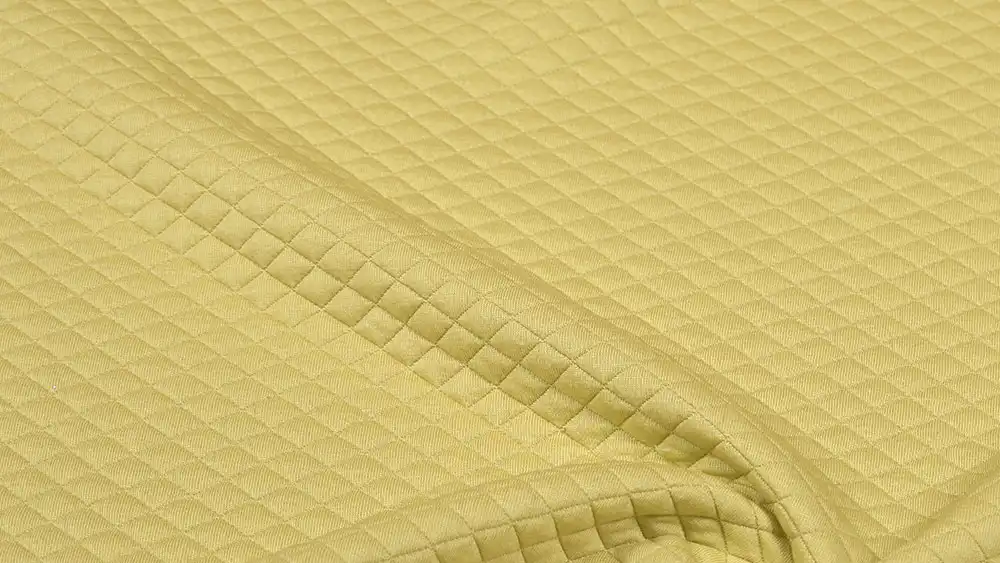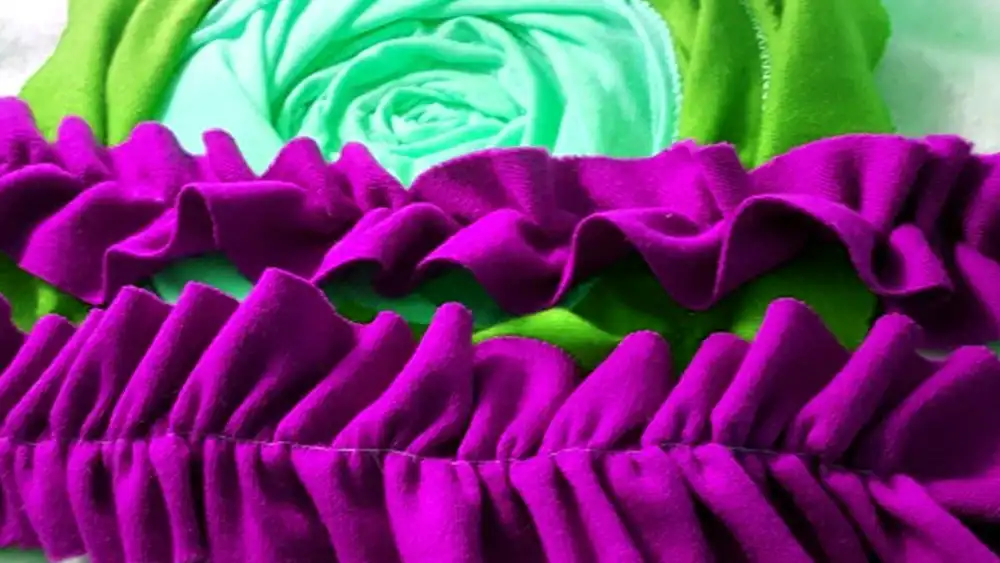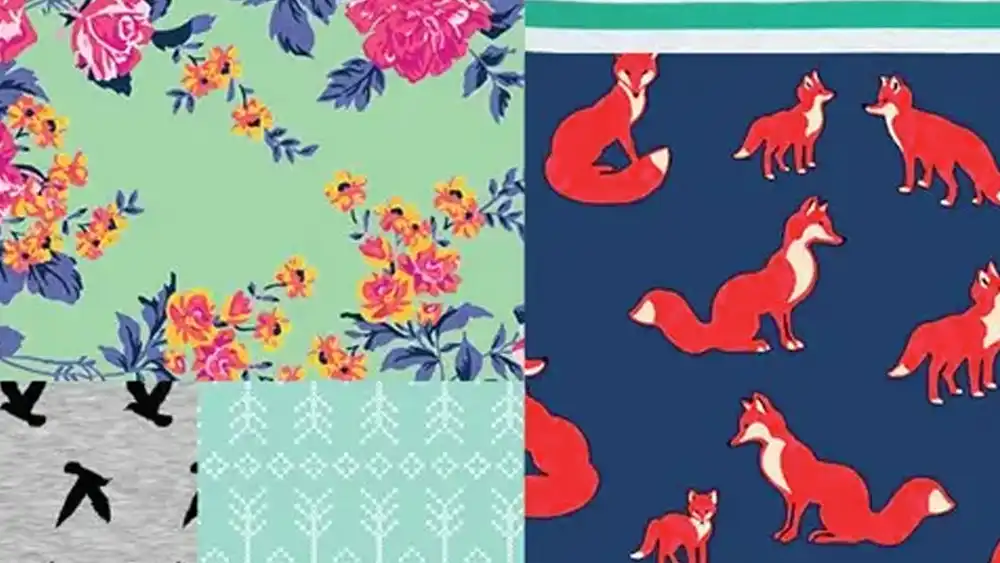Are you passionate about quilting? Do you want to explore new techniques and materials to enhance your craft? If so, then you’re in for a treat!
How to Make a Quilt With Knit Fabric? In this guide, we’ll delve into the art of making quilts with knit fabric. Get ready to infuse your projects with creativity and charm.
What Is Knit Fabric?

Before diving into the quilting process, let’s take a moment to understand what knit fabric is. Unlike traditional woven fabrics, knit fabric is made through a continuous loop of yarn.
This unique construction gives knit fabric its stretchiness and flexibility, making it ideal for various sewing projects, including quilting.
What to Do With Knit Fabric Scraps?

When you’re done with your quilt project, you may find yourself with leftover knit fabric scraps. Instead of letting them go to waste, there are plenty of creative ways to put them to good use:
- Patchwork Projects: Use your knit fabric scraps to create patchwork projects such as small quilts, pillow covers, or tote bags. Combine different colors, patterns, and textures to add visual interest and personality to your creations.
- Fabric Jewelry: Transform your knit fabric scraps into stylish fabric jewelry pieces such as fabric earrings, bracelets, or necklaces. Cut the scraps into small shapes, layer them, and attach them to earring hooks, bracelet chains, or necklace cords for a unique and colorful accessory.
- Fabric Appliqués: Cut out shapes or designs from your knit fabric scraps and use them as appliqués to embellish clothing, accessories, or home décor items. Appliqué techniques such as fusible webbing or hand-stitching can be used to attach the fabric shapes securely to the base fabric.
- Stuffing for Toys or Pillows: If you have larger scraps or leftover pieces, consider using them as stuffing for homemade toys, stuffed animals, or throw pillows. Cut the scraps into smaller pieces or shred them to create a soft, fluffy filling that adds volume and texture to your projects.
- Fabric Accessories: Get creative and make fabric accessories such as headbands, scrunchies, or fabric bows using your knit fabric scraps. These accessories are quick and easy to make, and they’re perfect for adding a pop of color and style to your outfits.
- Fabric Art: Use your knit fabric scraps as a medium for fabric art projects such as collage, mixed media, or fabric painting. Arrange the scraps on a canvas or fabric backing to create colorful and textured compositions that can be displayed as wall art or incorporated into other art projects.
- Fabric Coasters or Trivets: Cut your knit fabric scraps into square or rectangular shapes and use them to make fabric coasters or trivets. Layer the scraps with batting and backing fabric, quilt them together, and finish the edges with binding for a practical and stylish addition to your home.
- Fabric Scrunchies: Make trendy fabric scrunchies using your knit fabric scraps. Cut strips of fabric, sew them into tubes, and attach elastic inside to create stretchy hair accessories that are perfect for adding a pop of color to your hairstyle.
By finding creative ways to repurpose your knit fabric scraps, you can minimize waste and turn leftover materials into beautiful and useful creations. So don’t toss those scraps – get creative and let your imagination run wild!
Choosing the Right Knit Fabric

When selecting the perfect knit fabric for your quilt, there are several factors to consider. It’s essential to choose a high-quality material that suits your project’s needs.
Here are some key points to keep in mind:
- Weight: Consider the weight of the knit fabric. A medium weight is typically ideal for quilting projects, as it provides the right balance of stability and flexibility.
- Stretch: Evaluate the stretchiness of the fabric. Knit fabrics are known for their stretch, which can vary depending on the type of knit and fiber content. Opt for a fabric with enough stretch to accommodate movement without losing shape.
- Fiber Content: Pay attention to the fiber content of the fabric. Knit fabrics can be made from various materials, including cotton, polyester, rayon, and blends. Choose a fabric that suits your preferences in terms of feel, durability, and care requirements.
- Quality: Inspect the quality of the knit fabric. Look for smooth, even stitching and minimal flaws or imperfections. High-quality knit fabric will enhance the overall look and longevity of your quilt.
- Color and Design: Consider the color and design of the fabric in relation to your quilt’s theme or aesthetic. Whether you prefer solid colors, prints, or textured knits, choose a fabric that complements your vision for the project.
By carefully considering these factors, you can select the right knit fabric to bring your quilt to life with style and functionality.
How to Make a Quilt With Knit Fabric?
Creating a quilt with knit fabric adds a unique touch to your crafting repertoire.
Here’s a step-by-step guide to help you master this innovative quilting technique:
Prepare Your Materials:
Before diving into quilting, it’s crucial to ensure that your materials are prepped and ready to go. Pre-wash and dry your knit fabric to prevent any unexpected shrinkage or color bleeding later on. This step is essential for maintaining the integrity of your quilt over time. Additionally, gather all the necessary supplies such as batting, backing fabric, thread, and cutting tools to have everything at hand when you need it.
Design Your Quilt:
Designing your quilt is where your creativity can truly shine. Take some time to sketch out your ideas, considering factors such as color coordination, pattern placement, and overall theme. Knit fabric offers unique properties such as stretchiness and texture, so consider how you can leverage these characteristics to enhance your design. You might choose to create bold geometric patterns, playful appliqués, or even incorporate mixed media elements for added interest.
Cut Your Fabric:
Once you have a clear vision for your quilt design, it’s time to bring it to life by cutting your knit fabric into the necessary pieces. Use sharp fabric scissors or a rotary cutter and cutting mat for precision. Take care to measure accurately and cut smoothly to ensure clean edges and consistent shapes. Remember to account for seam allowances as you cut, as these will be crucial when piecing your quilt together later on.
Piece Your Quilt Top:
Piecing together your quilt top is where your design truly starts to take shape. Lay out your cut fabric pieces according to your design plan, experimenting with different arrangements until you find one that you love. Pin or baste the pieces together securely to prevent shifting during sewing. When it comes time to sew, consider using a stretch stitch or a narrow zigzag stitch on your sewing machine to accommodate the inherent stretchiness of knit fabric and ensure durable seams.
Assemble Your Quilt:
With your quilt top complete, it’s time to assemble the layers of your quilt sandwich. Lay down your backing fabric, followed by a layer of batting, and finally, your quilt top. Smooth out any wrinkles or bumps, and baste the layers together using safety pins or temporary adhesive spray to hold everything in place during quilting. Taking the time to properly layer your quilt will result in a finished product that is both visually appealing and structurally sound.
Quilt Your Layers:
Quilting is the process of stitching the layers of your quilt together to create texture, stability, and visual interest. There are numerous quilting techniques to choose from, ranging from traditional hand quilting to modern machine quilting. When quilting with knit fabric, it’s important to select a technique that complements the stretchiness and drape of the fabric. Consider experimenting with different stitch patterns, densities, and thread colors to achieve the desired effect.
Add Finishing Touches:
Once the quilting is complete, it’s time to add the finishing touches to your quilt. Trim any excess fabric and batting from the edges, ensuring a clean and uniform appearance. Next, apply binding to the edges of your quilt to encase the raw edges and provide a finished look. You can use either a stable knit fabric or a coordinating woven fabric for binding, depending on your preference and the overall aesthetic of your quilt. Secure the binding with a straight or zigzag stitch, being careful to miter the corners neatly for a professional finish.
Press and Enjoy:
Finally, give your quilt a final press with a steam iron to smooth out any wrinkles and give it a crisp, polished appearance. Take a moment to admire your handiwork and revel in the satisfaction of creating something beautiful and unique. Your knit fabric quilt is now ready to be enjoyed for years to come, whether as a cozy throw for chilly nights or a cherished heirloom to be passed down through generations.
By following these steps, you can create a beautiful and functional quilt using knit fabric, showcasing your creativity and skill in the world of quilting.
Conclusion
Creating a quilt with knit fabric opens up a world of possibilities for quilters of all skill levels. By understanding the unique properties of knit fabric and following these steps, you can craft beautiful and functional quilts that are sure to impress. So gather your materials, unleash your creativity, and start stitching your masterpiece today!
